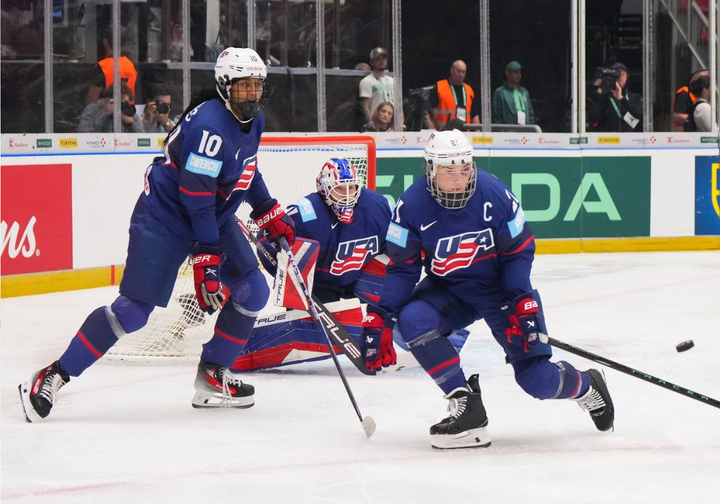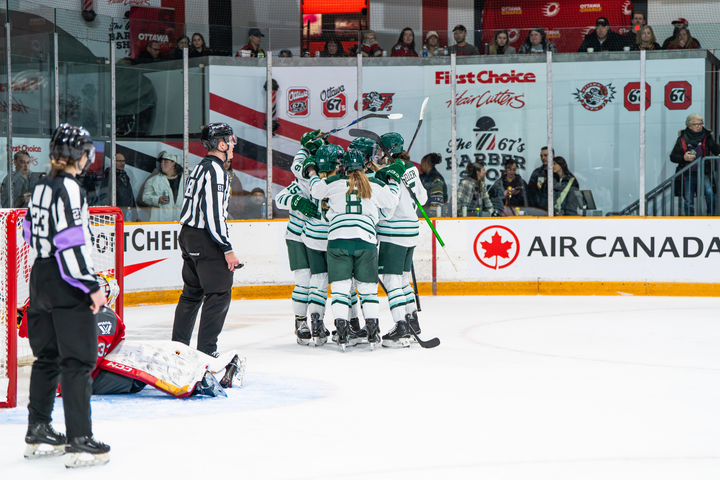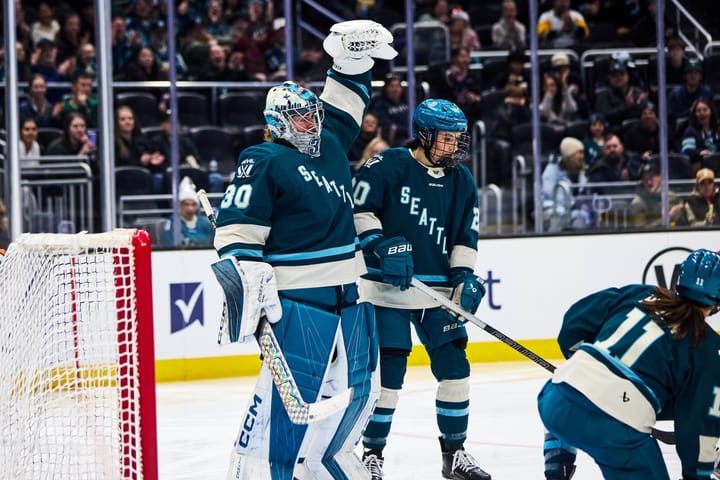The landscape of the NWHL without national team skaters
A statistical analysis of the performance of NWHL skaters across the league’s first three seasons.
The landscape of skill and talent has changed a great deal in the NWHL’s three-year history. This year the absence of the 2018 U.S. women’s national team — including Hilary Knight, Brianna Decker, and Amanda Kessel — from the league brought about the greatest change in that landscape. The majority of the NWHL’s most skilled and productive players left the league for the PyeongChang Olympics or for greener pastures in Canada, Asia, and Europe.
The vacuum created by these departures was noticeable. However, there was still an abundance of skill on the ice during the 2017-18 NWHL season. And that leaves us with quite a few questions to answer: How did the absence of established stars and household names affect the players who returned in season three? And how did the standout performances of the 2017-18 season compare to those from years one and two?
The Curious Case of Alexa Gruschow
About one month ago, I launched the NWHL Two-Player Comparison tool. The tool ranks players on a 1-100 percentile scale in a variety of categories — including individual metrics such as goals scored, penalty minutes (PIM), and evaluative tools such as Game Score. Ranking players by percentiles helps illustrate their impact not just in the aforementioned categories, but also helps us understand their influence on the outcome of games. I recently updated the tool to include historical data, which allows us to observe the perceived “improvement” of players between seasons.
In the 2016-17 season, MVP Brianna Decker ranked in the 99th percentile in four different metrics: goals, points, primary points, and shots. In other words, she was better than 99 percent of the NWHL’s skaters in those areas.
In comparison, let’s look at the ranks of Alexa Gruschow — this year’s MVP — in the 2016-17 season. Her average percentile rank in her rookie season was 65, with Gruschow’s highest rankings coming in assists (83), and PIM (80).
However, when we use the two-player comparison tool to compare Gruschow’s 2017 performance and her 2018 performance, we hit a stumbling block. Gruschow’s percentile ranks from this year look an awful lot like Decker’s 2017 numbers. In fact, both of her evaluative rankings (average percentile and game score) appear equal to or better than Decker’s. So, how did one skater go from being an upper-middle of the pack player to downright dominant in the space of one season?
The easy answer to that question is the loss of the national team players. However, as anyone with eyeballs and an Internet connection should be able to tell you, Gruschow’s individual play improved exponentially. She scored seven more goals, tallied five more assists, and registered 12 more shots in 2017-18 than she did in her rookie season. She was a different player.
New Blood in Season Two
The NWHL’s second season saw the entry of its first ‘true’ rookie class. That group included some truly dominant names in the women’s hockey landscape, such as Patty Kazmaier winners Amanda Kessel and Alex Carpenter, other Olympians, and 13 players who played in NCAA Championship Games. Of the 81 skaters who played in the 2016-17 season, 34 were playing in their first NWHL season — which translates to about 42 percent of all skaters.
The influx of that new wave of elite talent definitely showed in the percentiles. When looking at the league-wide change in the average percentile between the NWHL’s inaugural season and its second year, returning players lost four percentile points compared to their 2015-16 season ranking.
The Riveters roster saw perhaps the largest influx and overall change. Bray Ketchum, one of the original Riveters, is a poignant example of this phenomenon. In the 2015-16 season Ketchum was the Riveters top goal scorer (10) and she finished second in points (13). In the 2016 offseason, the Riveters added Gruschow, Miye D’Oench, Kessel, Rebecca Russo, and others. As a result, Ketchum took a serious hit on the depth chart.
In the 2016-17 season Ketchum scored just two goals, good for seventh on her team. As a result, her percentile rank tumbled. The drop in Ketchum’s production resulted in an average drop of 25 percentile points in each of the tool’s metric categories. As expected, the influx of new talent on the Riveters in 2016-17 and the change in Ketchum’s role made a dramatic impact on her percentile ranks.
Centralization’s Impact in Season Three
If the 2016-17 season was statistically influenced by the influx of its first true rookie class, the 2017-18 season will be remembered for how centralization impacted the league and its most productive players.
Centralization (or “residency”) is a strategy shared by USA Hockey and Hockey Canada during Olympic years. Players on the two national teams centralize in separate locations where they train for the Olympics full-time. As a result, those players rarely play with their professional clubs in Olympic years and if they do, it is typically just for a few games.
When we tally up the NWHL players lost due to centralization and free agency, we find that around 15 percent of skaters from the 2016-17 rosters were absent in 2017-18. Of course, that group was not just a random collection of skaters. Those players were almost all among the league’s elite, especially in regards to their percentile rankings. Those departed players had an average percentile rank of 71 across all metrics in the 2016-17 NWHL season.
Because of that, we’d expect to see a rise in the percentiles from the players who did return in 2017-18. This held true as, on average, percentiles rose by 10.02 percent league-wide. Thus, when looking at player ratings for the 2017-18 season (particularly in the case of athletes scoring above the 71st percentile), we need to take into account this point rise in order to find their “true score” and more accurately compare seasons.
Buffalo Beauts’ veteran forward Kourtney Kunichika is a textbook example of this trend. In 2016-17, Kunichika scored two goals and tallied nine assists for 11 points, placing her in the 71st percentile. In 2017-18, she scored four goals and had 10 assists, improving to the 81st percentile — exactly a 10-point rise.
If we look closer at Kunichika’s comparison charts, we see that in goals, assists, and points, she ranked above the 71st percentile. In 2018, we saw that expected 10 point rise in almost all categories for the Beauts veteran. Kunichika’s goals — where she was previously ranked just above the league average — saw a massive leap. She finished in the top quartile of NWHL skaters in 2017-18. While some of that can be accounted for with an era adjustment, Kunichika still had a great goal-scoring season. It’s also worth noting that her shooting percentage jumped from 7.7 percent in 2016-17 to 16.67 percent in 2017-18.
Similarly, Defender of the Year Courtney Burke also saw improvements across the board this year; particularly in shots, points, and primary points. With an average improvement rate of 15 percentile points, Burke was clearly a benefactor of the massive change in rosters. She flourished in the new-look NWHL.
Burke’s jump in point production was unsurprisingly tied to the Riveters’ greatly improved offense. It stands to reason that a first-pair defender who is also the quarterback of the power play on a team that averaged four goals per game is going to pick up a lot of assists. It will be interesting to see if the Riveters can maintain that scoring rate next season if the 2018 Olympians return to the league.
While we should expect some regression next season, I don’t expect Burke to disappear into the woodwork anytime soon. Her impact as a defender has been nothing short of exceptional in her first two seasons. Burke projects to be a productive player for as long as she remains on NWHL ice.
Of course, there were players who were immune to the league-wide average percentile jump. However, those players overwhelmingly fell into one of two categories. The first is players with a 2016-17 average percentile of less than 72; almost all of the players who experienced a negative trend in their numbers started, on average, below 50. The second category is players who had a shortened season due to injury and/or outside circumstances.
Returning to Gruschow, the numbers reveal that she didn’t miss a beat stepping into the role of the Riveters’ top forward. The sophomore was truly the league’s top centre. No one else even came close to scoring as many goals, taking as many faceoffs, or averaging the number of points she did during the NWHL’s 16-game regular season.
Gruschow’s meteoric improvement in her second season can be seen clearly in the graphic above. She had an average increase of 32 points across the categories of the NWHL Two-Player Comparison Tool. Even if we negate not just the 10.02 percent average, but the full 15 percent of the top players who left the league in the 2017 offseason, Gruschow still shows a 15 point increase. Furthermore, that assessment is based on the assumption that every single one of those players ranked higher than her in each and every category.
Gruschow’s growth in her second season was nothing short of remarkable. She exceeded all expectations with the new role and ice time that was entrusted to her. Gruschow probably isn’t Brianna Decker and next year we should expect to see some regression, but there’s no denying the growth in her game and her status as an elite forward.
Onwards and Upwards
We will get a much clearer picture of how the absence of the NWHL’s U.S. women’s national team players affected the league as we move forward.
For now, the statistical evaluation of that impact is best represented by that average 10 percentile point jump from the 2016-17 season to this year. Will players like Gruschow see their numbers crash if a significant number of national team players return? Or will their experience playing in bigger roles this year help them close the gap on household names like Decker and Knight?
If the women of the U.S. national team return to the NWHL next season, we should have answers to those questions. If they don’t return, we can take comfort in the knowledge that the 2017-18 season was concrete evidence of the depth of talent in the women’s game.





Comments ()